Video Vitals
Analyzing the Season: What Makes the Perfect Holiday CTV Ad
by The QuickFrame and MNTN Teams10 min read
In partnership with:

Abstract
- Holiday shopping is beginning sooner than ever
- Holiday messaging directly drives ad performance
- Personalization and specificity are boons for holiday marketing
- Key attributes like emotions, keywords, and topics generate impacts on ROAS
Table of Contents
The Holly, Jolly (Holiday Advertising) Season
If we were a betting team of researchers, we’d say that you’ve experienced – at least once in your life – a friend, loved one, or casual acquaintance lose their cool after hearing the twangy, jangly guitar intro to “Jingle Bell Rock.” Christmas music, and holiday advertising in general, have begun appearing earlier and earlier in the year, so much so that it’s practically become a meme to complain about hearing “Frosty the Snowman” in late September.
But Christmas’ slow creep into non-Christmasy months is indicative of something that goes beyond grumbling about department store music. The reason why we see ads targeted towards the holiday season–inclusive of Halloween, Thanksgiving, New Years, and even Black Friday–is because consumers are starting their end-of-year holiday shopping earlier than ever before.
In 2021, Statista reported that:
- 46% of consumers shop for the holiday season prior to October.
- 25% prior to Thanksgiving
- 19% after Thanksgiving
- 1% shop for gifts in January
As consumers plan and budget for the holiday shopping season sooner than ever before, brands must ensure they are strategizing, producing, and deploying their holiday ad creative the moment holiday shopping begins.
So you know you need to produce holiday ad creative sooner rather than later, and ensure that it is running on the platforms and channels your audience most frequently visits. But there’s one big looming question we know you have in the back of your mind:
What are the creative elements that make a stellar holiday ad?
Let’s break down a few of the key attributes you should consider when strategizing and producing your next holiday ad campaign.
Deconstructing Holiday Ad Creative
To best understand what makes for an effective holiday ad, we must first understand what influences consumer shopping behavior during this time of the year. According to a separate study from Statista, the most important factors for making a purchase are:
- Price: 75%
- Convenience: 62%
- Speed of delivery: 48%
From an ad creative perspective, what this data immediately highlights are messaging and language strategies you should thread into your creative. As an illustration, since price and convenience are key to consumers, a brand could craft language that surfaces cost-efficiency or the ease a product can provide someone’s life. Consider this information as a launch pad for your own creative concepting.
But we can actually get a little more nuanced than those key data points. In 2020, QuickFrame by MNTN analyzed nearly 1000 videos published on social channels during the holiday season. Their analysis revealed that messaging that expressly features holiday language directly affects ad performance. Videos with holiday messaging had 58% higher average engagement rate than those without. That was social media, but what about Connected TV?
Recently, QuickFrame and MNTN analyzed different CTV creative from holiday ads in Q4 of 2021 to surface new best practices strategy for the holiday season. Questions that we asked were:
- What were the major topics that each ad focused on?
- What keywords were used most frequently?
- What emotion created the biggest impact?
Let’s break down our findings.
Topics
Let’s look at the topics that generated the greatest impact on ROAS across all verticals:
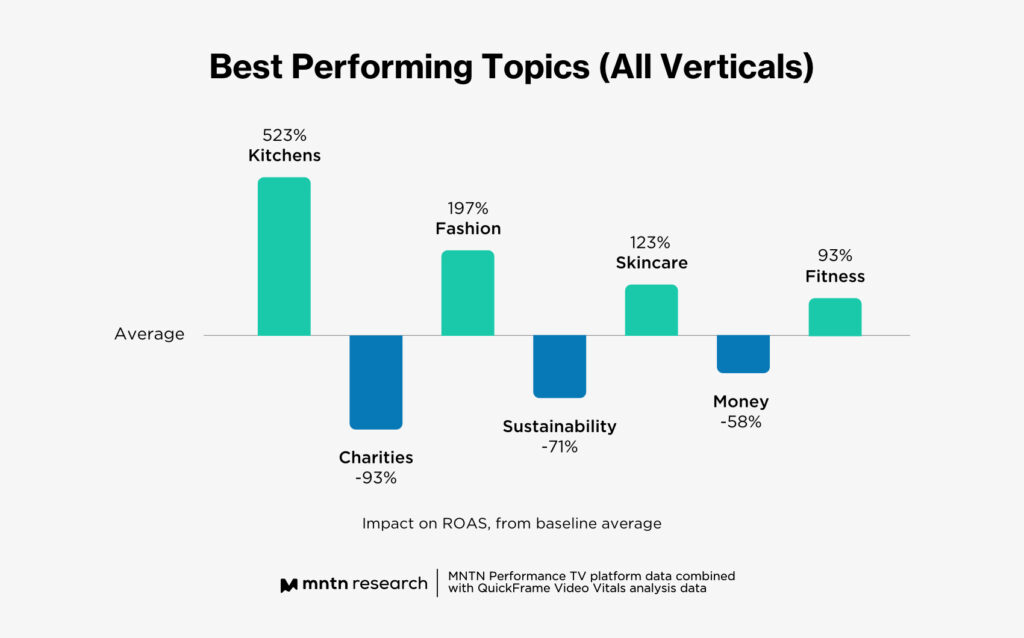
What can we say? A lot of folks brushed off the cobwebs from their cookbook shelves during the pandemic, so it’s no wonder “kitchen” was a leading topic at the end of 2021. But the holidays are also a time for family gatherings. Preparing delicious food and drink (in the kitchen) with your loved ones is central to that familiar experience.
This fact allows you to make a confident assumption that the words “kitchens” and “food and drink” generate positive impacts because it reminds us of warm, fond memories of the holidays.
But despite this being the season of giving, topics with a more philanthropic bent, like charities and sustainability, saw a decline in performance. This isn’t entirely unexpected. At the end of an emotionally fraught last two years, we’re not fully surprised that consumers were more focused on themselves rather than any form of philanthropy. That doesn’t mean you should give up these topics, as 82% of consumers want a brand’s values to align with their own. As economic uncertainties slowly stabilize, we fully anticipate topics that lend themselves to philanthropy to begin to gradually bounce back.
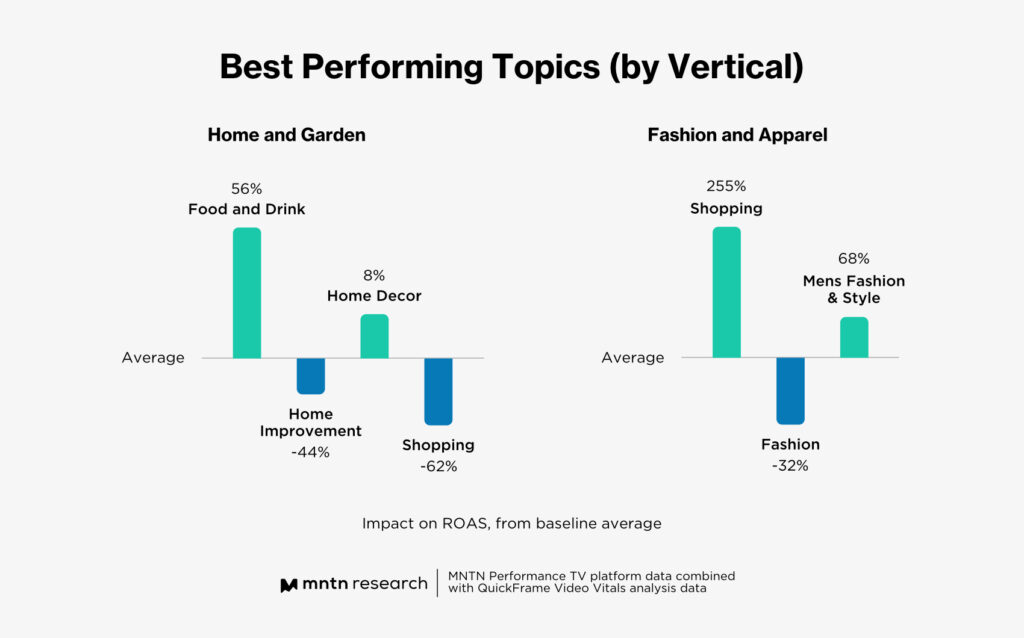
Takeaway for Topics
After being home for well over a year, we had already completed our DIY projects or finished up home improvements to make our home offices more comfortable. It’s not surprising that those two topics saw substantial decreases. As you can see from the data, we were far more interested in getting back into the entertainment side of life that we may have had to put on hold since 2020.
The fashion vertical also gives us a key insight into the power of personalization. There was a large discrepancy in performance between “Men’s Fashion and Style” and “Fashion.” Use this data as permission to be even more specific with your messaging during the holiday. Your campaigns will benefit from crafting language that speaks to the specific desires of each unique audience you wish to target.
Keywords
Just like with topics, let’s dive into the keywords (including both spoken words and on-screen text) that drove the greatest ROAS across all verticals.
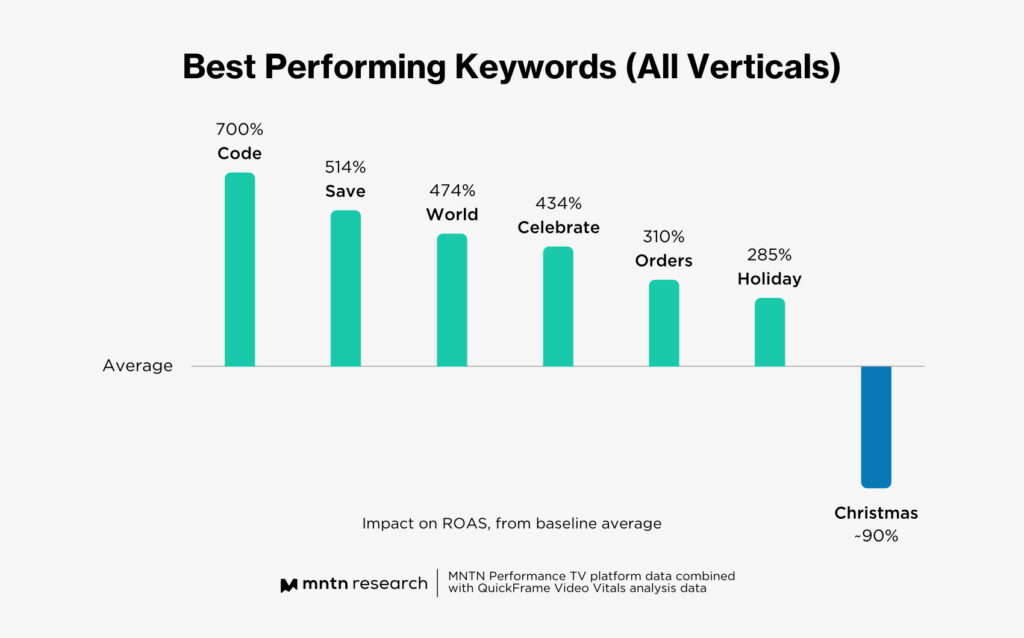
The most fascinating data point we discovered in our analysis was that ads featuring the keyword Christmas actually led to an overall decrease in the baseline average. While we said specificity is your friend in holiday ad campaigns, when it comes to actual holiday keywords, you’re better served by a more covert–or even nondenominational– way of expressing holiday sentiments. Generally talking about the holidays, or using words that can represent the “holiday spirit” like “celebrate” or “world” (as in world peace), may be more suitable to a broader audience.
Let’s double click into a few other keywords associated with a decrease in performance:
Chance
What word do you think goes with chance? Is it last? Because it’s most likely last. Last chance messaging engages a sense of fear–or FOMO more accurately. If you want to get shoppers to engage before their “last chance to buy presents”, then stray away from using the phrasing in your ads.
Delicious
You know your product is delicious, and you want to convey that to your customers. But tastes are subjective, so rather than saying “oh this will taste so great” be more descriptive so you can satiate their appetites with more transparency.
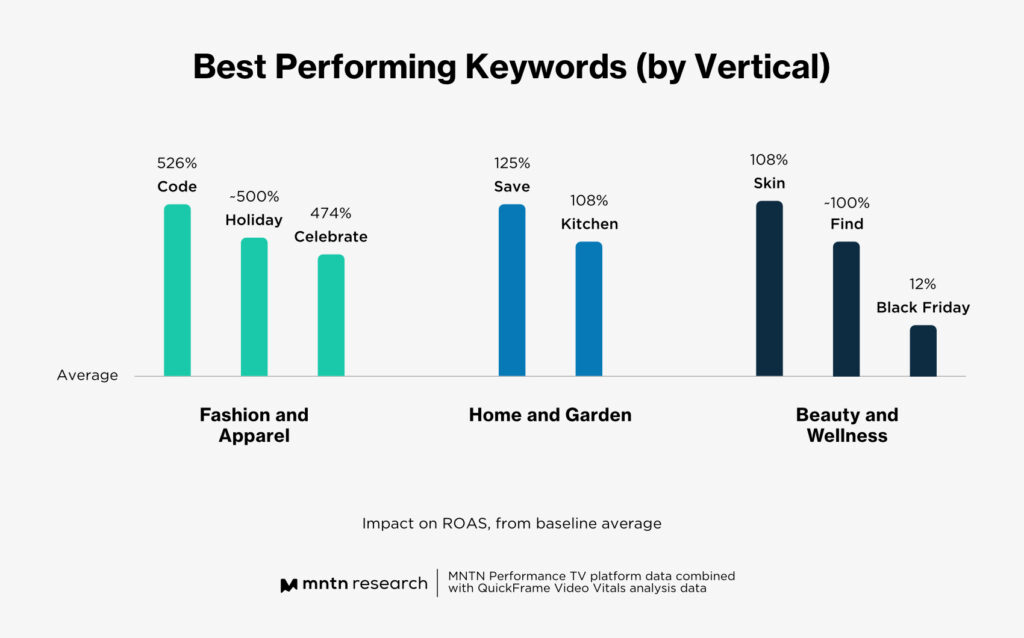
Takeaways for Keywords
From a high-level perspective, taking into account the increased performance for the words code and save, zero in on words that convey savings to your customers (whether it’s with a discount code or an everyday deal.)
An interesting keyword to double click into is “find’ in Beauty and Wellness. When I think of wellness brands, I think of more inspirational ad copy where you’re asked to “find yourself” or “find your moment” or the more eloquently put “find what feels good.” When everything in the beauty and wellness space is about finding something, maybe you should find a way to include it in yours this year.
Emotions
Accounting for joy, anger, fear, and sadness, we found these emotions drove ROAS across these verticals.
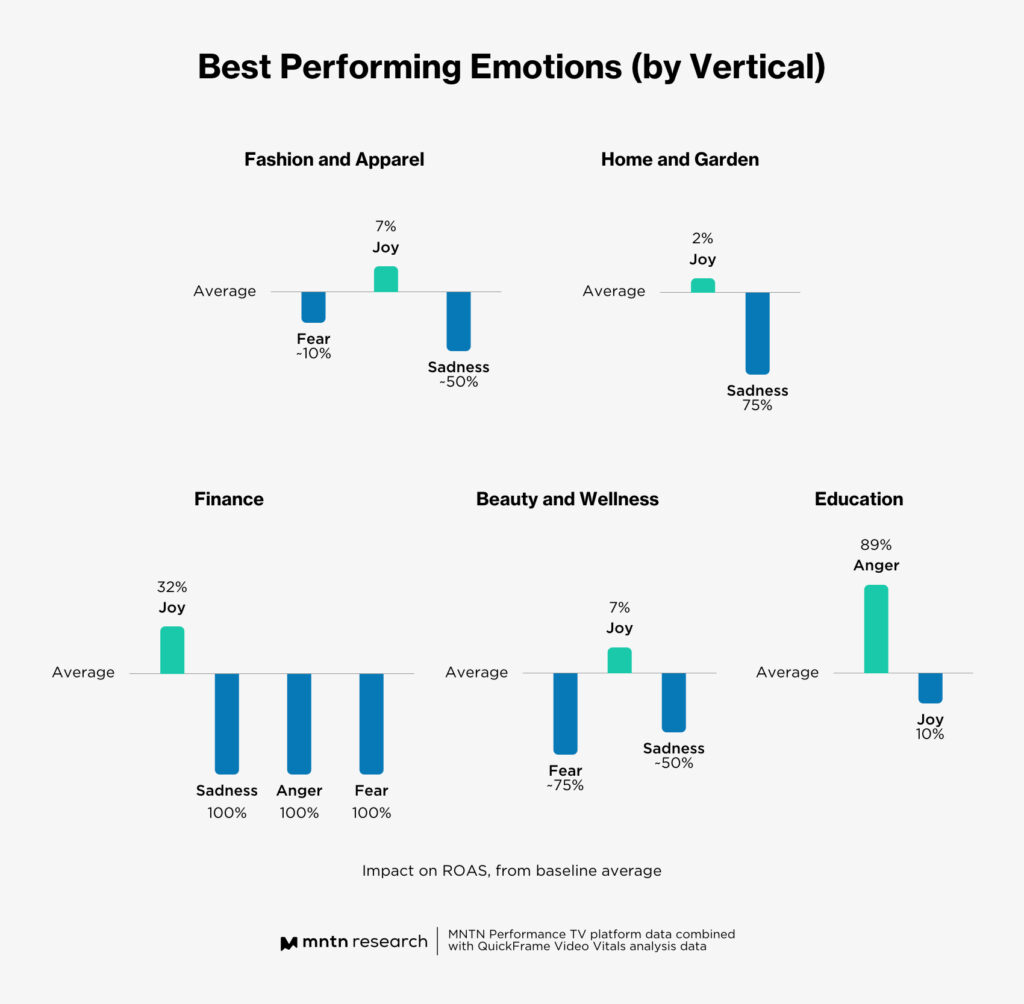
It shouldn’t come as a shock that joy absolutely crushes it during the span of three months a lot of folks call “the most wonderful time of the year.” And especially after these last few anxiety-filled years where fear was an ever present message in news and media, we’ve developed a sort of blindness to fear messaging, and have come to crave the comfort of happier thoughts.
But we did want to point out that, according to a late 2021 analysis QuickFrame and MNTN conducted on CTV ads, we saw positive results using fear-based messaging when your goal is improving Visit Rates.
While fear, sadness, and anger decreased for many brands, they hit the bottom for the finance industry. Think of it like this: the world is already stressed and worried about financial security, so don’t prioritize that in your ads. Instead, fill your viewer with the joy of becoming economically secure.
Takeaways for Emotions
The most interesting datapoint we discovered was that anger really drove performance for the education industry.
Many people decide to go back to school later in life because they are angry about being stuck in a dead end job, or they feel frustrated that life has gotten in the way of following their passions. By front loading this type of language, you establish an authentic connection with the viewer because you’re speaking directly to their unique experiences.
Another reason why anger is generating an impact may be due to the rising cost of college that has led prospective students to feel they don’t have the financial ability–or simply the time–to continue their education.
This frustrating feeling can best be described as anger at a broken system, which is why an anger message resonates. You’re telling the viewer that not only do you understand their pain, but you share their anger too.
Top Industries for Holiday Ads
- DTC
- CPG
- Toys
- Gaming
- Fashion/Beauty
- Ecommerce
Top Use Cases for Holiday Ads
- Conversion
- Awareness
- Consideration
Effective Best Practices for Holiday Ads
- Customize your CTA for different audiences and holidays. As a gift-giving holiday approaches, consider threading in more urgency in your messaging.
- Nail down your target audiences. Remember, you will want to target the buyers of gifts, not just the actual recipient.
- Plan specific content for the big shopping days: Black Friday, Cyber Monday, and then time-sensitive content as the gift-giving holidays inch closer.
- Map out your content across the entire buyer’s journey, including content you might post organically. By scoping out an entire campaign, you can be more efficient in your holiday video production, maximizing your shoot to capture the footage you’ll use over the entire quarter.
What the Industry is Saying
“While some people will shop for the holidays exclusively online or in-store, the majority will probably split their purchases between the two. In fact, a recent Shopkick study found nearly half of consumers (43%) plan to do most of their holiday shopping in-store, which means marketers need to make appeals to online and in-store shoppers alike.”
Kristen Gall (AdWeek)
“Stop selling your product. It sounds counterintuitive, but some of the best [holiday] campaigns have succeeded because they created a feeling for the audience, or recreated an experience, feeling of nostalgia, or childhood event. Don’t shy away from that, and only focus on targeted sales and leads.”
Christina Hager, Ovations Digital (Forbes)
“The formula for “good” creative hasn’t changed much since marketers first used it to draw in a discerning audience. Essentially, it’s about telling an engaging story that people can connect with and relate to. What has changed, however, is the way that story is told. This is especially true around the holiday season; it’s a time when shoppers aren’t so much influenced by promotional content, but by emotion. In fact, a Facebook-commissioned consumer research study showed a profound shift from utility to inspiration. More and more people are entering the shopping experience with interest in mind, not intent, and are waiting for that “special something” to inspire their next move.”
Meta for Business
Wrapping Up the Holidays
It doesn’t matter what industry you’re in, or the type of product you sell, a strong holiday video marketing campaign is essential in your end of year strategies. As holiday shopping is beginning earlier with each passing year, so too must your strategies be formulated earlier than you may have originally planned.
However, as our data revealed, there are tried-and-true holiday ad strategies you can adopt into your own campaigns to make concepting for the seasonal advertising blitz just a little bit easier. Prioritize language that expresses cost-savings or special offers to alleviate shopping anxiety. Be specific about the types of products you are promoting, even if you are not specific with the holiday you are targeting.
But above all else, remain authentic. This is a season of honesty, care, and transparency–that’s a gift your audience will cherish throughout the year.
Subscribe to the MNTN Research Weekly
Sign up to receive a weekly feed of curated research, sent straight to your inbox.